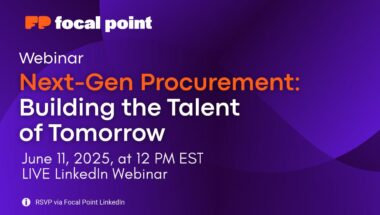CPOs can leverage a variety of strategies to navigate challenging economic times. Here’s how…
CPOs, think for a minute about how you manage your household budget and bill payment. Mortgage, electric, water, Internet service, car payment, groceries, recurring subscriptions, etc. How do you track everything and ensure bills are paid on time and kept on budget? At best, you may have an Excel spreadsheet set up and multiple auto payments pulling from one or two bank accounts. Variable costs that are paid in cash at the point of sale like groceries need to be updated manually. It can be quite a headache to keep up.
Now–imagine you oversee a budget of billions of dollars and deal with hundreds or thousands of vendors and service providers each with their own terms, contracts, payment preferences (check, wire, ACH). That family budget Excel spreadsheet isn’t going to cut it for your company’s Accounts Payable department. Sure, there’s nothing really sexy about AP, but “ways to save money” is enough to pique the interest of any CFO–especially in a time of high inflation and tough economic times.
According to a recent PwC pulse survey, Chief Financial Officers (CFOs) are prioritizing investments in digital upskilling and capabilities in data analytics, artificial intelligence and cloud to improve cost structure, reinvigorate the workforce and drive company revenue strategies. Likewise, in procurement departments, which are closely tied to the CFO, Chief Procurement Officers can leverage a variety of strategies to navigate challenging economic times. Here are three things related to AP that CPOs can implement and work towards for a positive bottom and top-line impact.
Aim for a Unified View of Transactional Data
American writer Jonathan Raymond said: “You can’t know what you don’t know. You can’t know about things you have yet to discover.” While Raymond’s view may conjure up images of hiking along the Appalachian Trail or ice climbing in Switzerland, it has a more detrimental connotation here. When accounts payable teams don’t know what is happening in their procurement processes, they are missing key pieces of information and inadvertently sabotaging those cost structure improvements the C-suite is demanding. Accounts payable must have the visibility and knowledge of all procurement activities, as blind spots today will cause problems of tomorrow.
Procurement orchestration that covers activity intake, execution, collaboration, and performance management has largely been fragmented across enterprises and managed through a variety of off-the-shelf point solutions that are limited in scope and lack a single-pane-of-glass view. Being a procurement veteran, I know that most of this data is siloed across an organization, in spreadsheets, emails and other documents.
In fact, when I’ve shown a head of procurement or CPO something as basic as being able to view and reconcile the transaction journey from the time of inception to the time an invoice is paid, while documenting all touch points along the way in one place outside of spreadsheets, they are often completely surprised this was even possible. With this level of visibility across all departments and business units, procurement teams can provide AP with much more clarity about what needs to be paid and when. Taking procurement-related AP activities out of spreadsheets and email threads, CPOs can more closely focus on strategic activities–such as evaluating suppliers and their practices in order to ensure alignment with ESG and DE&I goals that may have a longer term brand impact.
How CPOs Can Ensure A Streamlined AP Approval Process
In addition to achieving a more holistic view of transactions all the way down to accounts payable, ensuring a streamlined approval process among varying departments will increase efficiencies and reduce the possibility of duplicate payments or worse. In fact, many businesses have fallen prey to fraud by paying millions of dollars in phony invoices for products and services never ordered or delivered. Sadly, it’s more common than you would think.
In order to turn procurement activities and their interdependent accounts payable functions to areas that provide a competitive advantage, enterprises must first know where all their spending comes from and who has approved those purchases–whether that be marketing, product teams, legal, HR, etc. Guarding against unauthorized payments can’t be achieved without having a full understanding of the nature and scope of the transaction journey, from start to finish.
Yet even despite the rapid growth in digital transformation these past few years, many legacy processes still rely on manually inputting spending and approval activities across separate spreadsheets, creating those siloed sources of data across an organization that put procurement and AP teams at a great disadvantage. A lack of control automation in any accounts payable processes can lead to mistakes, unnecessary time spent on manual data entry processes and ultimately overspending.
CPOs Should Take Advantage of Their Existing Capital
In tough economic times, cash is king. With the current high cost of obtaining capital through debt, or added dilution through equity, procurement can be used strategically to maximize the use of existing capital. An elevated weighted average cost of capital (WACC) means a higher cost to financing and greater risk. However, AP can actually be used much more strategically. Large enterprises could be losing millions of dollars–even more–by not negotiating their payment terms or having a strategic plan or process for paying invoices.
By shifting from a net 30 to net 45 or net 60 with their vendors, enterprises can re-invest that capital into other areas of the business. Even sitting in a low-risk money market account or some kind of short-term cash equivalent until absolutely needed is still putting cash to work. If done strategically, this allows procurement leaders to use existing capital instead of taking on additional short-term debt for other projects. However, without a top-down view of the accounts payable process, this isn’t possible. More often than not, invoices come in, and then they are paid without thinking about those terms.
Easier still, is to take a look at your contractual payment terms and compare them to your actual accounts payable behavior. It is very common for AP to function as a “service” department and process payments as quickly as possible. Too many AP managers receive calls from internal constituents urging them to pay invoices right away, regardless of what the term is. This can result in that hard fought and gained payment term to be washed away. Sadly, many treasurers have had to acquire capital on the open market that could have been gained by enforcing the contracts already in place.
A Brighter Future
Today, with SaaS solutions that automate processes and provide holistic views of spend activities, accounts payable and procurement departments have an opportunity to save their enterprises money by shifting these functions from pure cost centers to strategic contributors to the top and bottom line. Additionally, such tools can work together for procurement activities, in a way that unifies data from multiple legacy platforms. It doesn’t have to be a daunting task. With the right field of vision, CPOs can transform their spend activities into new ways to generate revenue, renewing ambition to their enterprise’s revenue strategies during this economic downturn.
Originally published by Procurement Magazine on September 5th, 2022.



